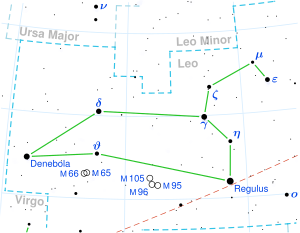Regulus
| Observation data Epoch J2000 Equinox J2000 |
|
|---|---|
| Constellation | Leo |
| Right ascension | A: 10h 08m 22.311s BC: 10h 08m 12.8/14s |
| Declination | A: +11° 58′ 01.95″ BC: +11° 59′ 48″ |
| Apparent magnitude (V) | 1.40/8.13/13.50 |
| Characteristics | |
| Evolutionary stage | Main sequence |
| Spectral type | B8 IVn + K2 V + M4 V |
| U−B color index | –0.36/+0.51 |
| B−V color index | –0.11/+0.86 |
| Variable type | Suspected |
| Astrometry | |
| Radial velocity (Rv) | +5.9/+6.3 km/s |
| Proper motion (μ) |
RA: -248.73 ± 0.35 mas/yr Dec.: 5.59 ± 0.21 mas/yr |
| Parallax (π) | 41.13 ± 0.35mas |
| Distance | 79.3 ± 0.7 ly (24.3 ± 0.2 pc) |
| Absolute magnitude (MV) | –0.52/6.3/11.6 |
| Details | |
| α Leo A | |
| Mass | 3.8 M☉ |
| Radius | 3.092 ± 0.147 R☉ |
| Luminosity | 288 L☉ |
| Surface gravity (log g) | 3.54 ± 0.09 cgs |
| Temperature | 12,460 ± 200 K |
| Rotational velocity (v sin i) | 347 km/s |
| Age | ≳1 Gyr |
| α Leo B/C | |
| Mass | 0.8/0.3 M☉ |
| Radius | 0.5/? R☉ |
| Luminosity | 0.50/? L☉ |
| Surface gravity (log g) | 4.4/? cgs |
| Temperature | 4885/? K |
| Other designations | |
| α Leo A: BD+12 2149, HD 87901, LTT 12716, SAO 98967. | |
| α Leo B/C: BD+12 2147, HD 87884, LTT 12714, SAO 98966. | |
| Database references | |
| SIMBAD | data |
Regulus, also designated Alpha Leonis (α Leonis, abbreviated Alpha Leo, α Leo), is the brightest star in the constellation of Leo and one of the brightest stars in the night sky, lying approximately 79 light years from the Sun. Regulus is a multiple star system composed of four stars that are organized into two pairs. The spectroscopic binary Regulus A consists of a blue-white main-sequence star and its companion, which has not yet been directly observed, but is probably a white dwarf. Located farther away are Regulus B, C, and D, which are dim main-sequence stars.
α Leonis (Latinised to Alpha Leonis) is the star's Bayer designation. The traditional name Rēgulus is Latin for 'prince' or 'little king'. In 2016, the International Astronomical Union organized a Working Group on Star Names (WGSN) to catalog and standardize proper names for stars. The WGSN's first bulletin of July 2016 included a table of the first two batches of names approved by the WGSN; which included Regulus for this star. It is now so entered in the IAU Catalog of Star Names.
Regulus is 0.46 degree from the ecliptic, the closest of the bright stars, and is regularly occulted by the Moon. Occultations by the planets Mercury and Venus are possible but rare, as are occultations by asteroids.
...
Wikipedia

